Author: insights4vc Source: substack Translation: Shan Ouba, Golden Finance
Coinbase announced strong financial results for 2024, with full-year revenue reaching $6.6 billion (up 111% year-on-year) and net income reaching $2.6 billion. The company also announced $3.3 billion in adjusted EBITDA, showing solid profitability despite the volatility of the cryptocurrency market.
Fourth quarter revenue reached $2.3 billion, up 88% month-on-month, mainly due to increased trading volume and strong participation in subscription and service revenue.
Financial performance was driven by the following factors:
Transaction revenue increased 172% sequentially to $1.6 billion in the fourth quarter.
Subscription and services revenue increased 15% sequentially to $641 million.
Crypto asset prices will rise by the end of 2024, especially Bitcoin and Ethereum.
Strategic expansion of derivatives trading, institutional adoption and regulatory clarity in the U.S.
Coinbase also strengthened its balance sheet, ending the fourth quarter with $9.3 billion in U.S. dollar assets, up $1.1 billion from the previous quarter. A large portion of its profits came from unrealized gains on cryptocurrency investments ($687 million for the full year), highlighting the market volatility Coinbase faces.

Coinbase Core Team:
Co-founder and CEO: Brian Armstrong
Co-founder and Board Director: Fred Ehrsam
President and COO: Emilie Choi
CFO: Alesia Haas
Chief Legal Officer: Paul Grewal
Regulatory Environment
The U.S. regulatory environment is shifting, with the Trump administration prioritizing cryptocurrency leadership and moving away from restrictive “enforcement regulation” policies. This opens the door to stablecoin and market structure legislation, improves the operating environment for centralized exchanges (CEXs), and reduces uncertainty around institutional compliance.
Coinbase has also received important international approvals, including VASP registrations in the U.K. and Argentina, and progress toward a MiCA license in the EU, enabling European expansion. Additionally, Coinbase won an interlocutory appeal in its litigation with the SEC, a key step in shaping U.S. cryptocurrency regulation.
Growth Strategy
Coinbase aims to increase trading volumes and expand market share, particularly in the following areas:
Institutional trading, up 139% year-over-year in 2024.
Derivatives markets, with Coinbase adding 92 new assets to its international exchanges.
Subscription-based services, such as Coinbase One, surpassed 600,000 users in the fourth quarter.
Stablecoin adoption, with USDC remaining a focus, facilitating over $12 billion in on-chain USDC payments in 2024.
Market Dependence and Competition: As a top-3 cryptocurrency exchange, Coinbase’s revenue is highly dependent on market sentiment, while growing competition from DEXs forces CEXs to innovate.
Regulatory Uncertainty: Despite regulatory progress in the United States, Coinbase faces global risks, especially in Asia and Europe where policies remain unpredictable.

Institutional Adoption and Crypto ETFs
Coinbase is successfully building an institutional flywheel, benefiting from:
ETFs drive record inflows, pushing Coinbase assets under custody (AUC) from ETFs to $93.2 billion.
7% of RIAs currently invest in cryptocurrency ETFs, up 41% since Q1 2024.
Derivatives volumes continue to grow, especially perpetual contracts and structured products.
This momentum suggests stronger demand for institutional-grade crypto products, which could further drive adoption of derivatives and prime brokerage services.
Base and the Role of On-Chain Scaling
Coinbase’s Layer 2 scaling solution, Base, continues to see outstanding success:
Base assets surged 89% in Q4 to $14 billion.
Stablecoin volume surpasses $25 billion.
More and more developers are building on Base, strengthening its role as the foundational layer for on-chain finance.
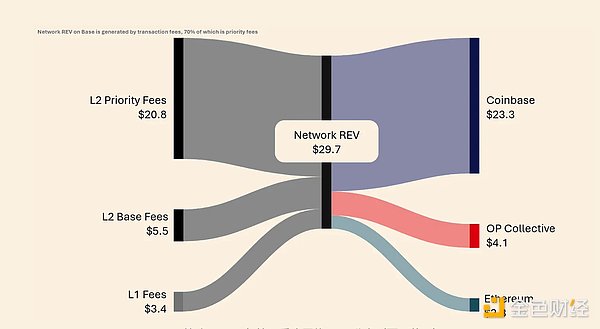
Coinbase's BTC-secured lending program is another major innovation that allows users to borrow USDC against their BTC holdings without having to sell their assets. This could create a new DeFi-native lending model that is directly integrated with the Coinbase ecosystem. Coinbase (COIN) vs. Robinhood (HOOD) Coinbase has responded to the crypto bear market and regulatory challenges by solidifying its position as the leading regulated exchange through continued investments in infrastructure, compliance, and global expansion. Robinhood has balanced its role as a brokerage with a more measured approach — focusing on cost-efficiency, achieving profitability, and delisting certain assets like Solana and Polygon in response to regulatory concerns. Despite these different strategies, Robinhood has strengthened its position in cryptocurrency trading. When the 2024 U.S. presidential election reignites retail trading interest, Robinhood is well positioned. In the fourth quarter of 2024 alone, its customers traded $71 billion in cryptocurrencies, almost as much as the first three quarters combined. Unlike Coinbase, Robinhood has leveraged its established brokerage client base to integrate cryptocurrencies into its broader trading ecosystem.
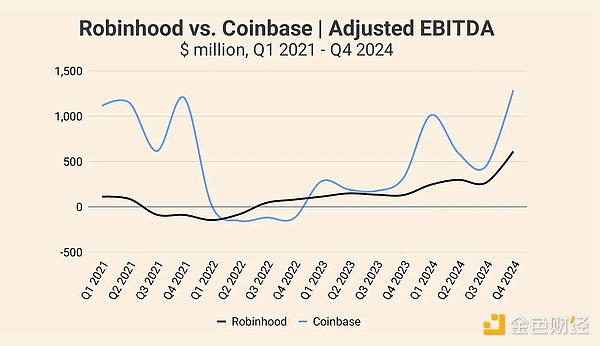
Trading Volume
In 2024, Robinhood's cryptocurrency trading volume soared to $143 billion (up 259% year-on-year), while Coinbase's retail trading volume was $221 billion (up 195% year-on-year). Historically, Robinhood's trading volume has occasionally exceeded Coinbase, such as in the second quarter of 2021, when a surge in DOGE trading drove its activity. At the time, Robinhood only supported seven cryptocurrencies, but DOGE trading accounted for 62% of its cryptocurrency revenue. A key differentiator for Robinhood is its ability to cross-sell cryptocurrency trading to its brokerage clients, nearly half of whom (12 million out of 25 million) participate in the cryptocurrency market.
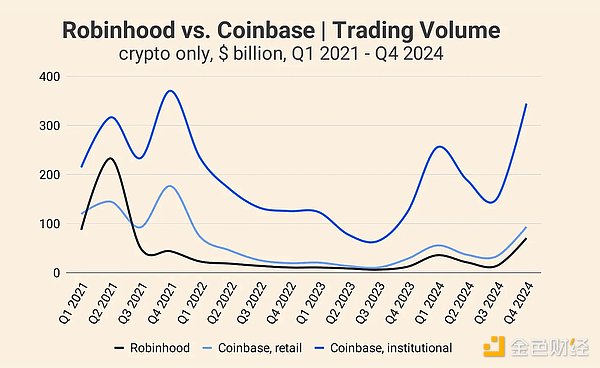
Revenue Comparison
Although Robinhood's cryptocurrency trading volume has increased, its cryptocurrency-related revenue will reach US$626 million in 2024 (a year-on-year increase of 363%), which is significantly lower than Coinbase's US$3.43 billion (a year-on-year increase of 157%).
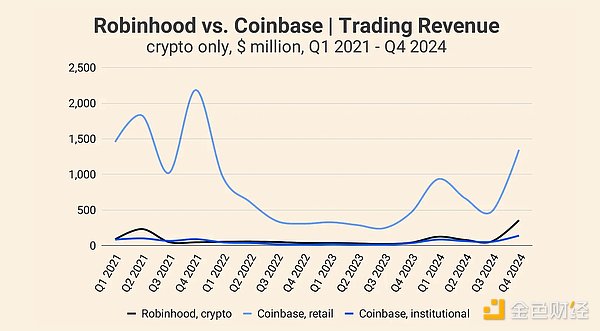
This difference is mainly due to lower fee rates - Robinhood's fee rate in the fourth quarter of 2024 is 0.50%, up from 0.23% in the first quarter of 2022, while Coinbase's fee structure is higher. Robinhood has room to adjust its pricing model without compromising its competitive advantage in affordability.
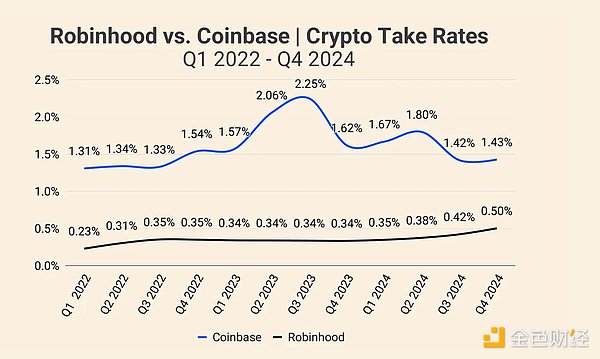
Bitstamp Acquisition
Robinhood's planned acquisition of Bitstamp, expected to be completed in the first half of 2025, represents Robinhood's strategic expansion into international and institutional markets. The combined trading volume of the two in 2024 ($252 billion) is very close to Coinbase's retail trading volume. Bitstamp's presence in institutional trading provides Robinhood with a new growth avenue that complements its existing retail-centric approach. However, Coinbase remains the dominant platform for institutions, with $941 billion in institutional trading volume in 2024 (up 140% year-over-year).
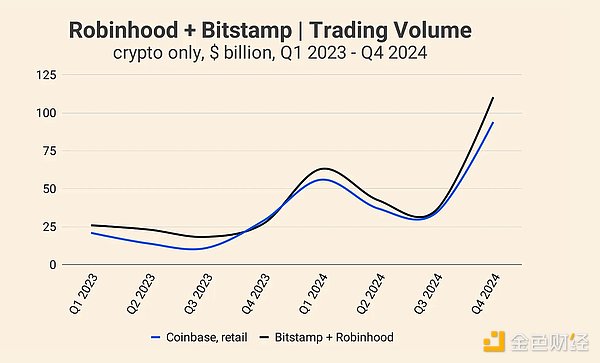
The Robinhood acquisition shows that the company is working hard to transform from a US-centric retail broker to a more diversified global cryptocurrency exchange. The success of this expansion will depend on regulatory conditions and Robinhood's ability to effectively integrate Bitstamp's business.
Institutional trading remains an area of strength for Coinbase, despite operating at a lower commission rate than retail, with institutional revenue of $346 million in 2024. Institutions prioritize liquidity, regulatory compliance, and market depth, and Coinbase has strengths in these areas. While Bitstamp strengthens Robinhood’s institutional positioning, it will take time for Robinhood to gain meaningful market share in this space.
Blockchain Strategy: Base vs. Robinhood’s Approach
Coinbase has been investing in blockchain infrastructure through Base, its layer 2 blockchain launching in Q3 2023. While Base currently contributes only a small portion of revenue, Coinbase sees it as a long-term driver of profitability and a path to deeper integration with decentralized finance (DeFi). Robinhood has yet to launch a blockchain initiative, which could limit its ability to compete in the emerging DeFi and on-chain finance space.
Beyond Trading: Subscriptions and Services as Growth Drivers
Coinbase has successfully diversified its revenue streams beyond trading. Its “Subscriptions and Services” segment expands from $45 million in 2020 to $2.31 billion in 2024, including staking, stablecoin revenue (USDC), custody, and interest income. Staking alone generates $706 million in revenue in 2024. While Robinhood offers staking services in the EU, it faces U.S. regulatory restrictions that limit its ability to expand this revenue source. The acquisition of Bitstamp could provide additional international market opportunities in this area, but regulatory considerations remain a key factor.
Stablecoins: Robinhood Enters Digital Dollar Market
Coinbase’s partnership with Circle brought in $910 million in stablecoin-related revenue in 2024. In contrast, Robinhood launched USDG under the Global Dollar Network in partnership with Galaxy Digital, Kraken, Nuvei, and Paxos. The revenue-sharing structure for USDG is unclear, but it demonstrates Robinhood's ambition to gain a foothold in the stablecoin space. If successful, stablecoins could become an additional revenue stream for Robinhood.
Tokenized Securities
Both companies are exploring opportunities to tokenize real-world assets. Robinhood's background in traditional finance and brokerage gives it a potential advantage in this space, while Coinbase's expertise in crypto infrastructure could allow it to enter the market through a blockchain-native approach. While Coinbase has shown limited interest in traditional brokerage, its expansion into tokenized securities could change that stance. The regulatory environment will play a key role in shaping the trajectory of this market.
Coinbase: Q1 2025 Outlook
Coinbase provided guidance for the first quarter of 2025, expecting:
Transaction revenue to be approximately $750 million for the year ended February 11, 2025.
Subscription and Services revenue is expected to be between $685 million and $765 million.
Transaction fees are high and are estimated to account for 15% to 20% of net revenues.
Technology and development and general and administrative expenses are expected to be between $750 million and $800 million, reflecting increased marketing activity and salary expenses.
Sales and marketing expenses are expected to be between $235 million and $375 million, impacted by performance marketing programs and the expansion of USDC rewards.
These forecasts highlight Coinbase's confidence in continued strong market performance, while also reflecting its increased spending potential to capture further growth in the institutional and retail sectors.
Coinbase's three main goals for 2025 include:
Increase revenue: Expand trading market share, increase USDC market capitalization, and increase subscription and service revenue.
Expand cryptocurrency utility: Increase stablecoin adoption, expand on-chain products such as Base, SmartWallet, and Coinbase Developer Platform.
Expand foundation: Strengthen regulatory engagement and ensure Coinbase remains the most trusted and scalable crypto platform.
Robinhood: Outlook for 2025
Crypto and Institutional Expansion
Robinhood’s cryptocurrency trading volume increased 400% year-on-year to $71 billion in the fourth quarter of 2024, and it plans to acquire Bitstamp in the first half of 2025 to attract institutional capital inflows. Although global regulatory risks remain, Ethereum staking in the EU and new listings in the United States have strengthened its position.
Active Trading and Derivatives Growth
Robinhood is expanding into advanced trading with index options, futures, and Robinhood Legend, competing with Interactive Brokers and Fidelity. With 477 million options contracts traded in Q4 (up 61% year-over-year), it dominates the retail derivatives space, but engagement and risk management are key challenges.
Global Expansion & Monetization
The company is growing in Asia Pacific, making Singapore its regional headquarters and expanding its UK business with options trading. Robinhood Gold currently has 2.6 million users (10% penetration), while its credit card business has over 100,000 cardholders and needs to improve execution efficiency amid regulatory complexity.
Investment Advisory & Wealth Management
The acquisition of TradePMR (H1 2025) marks Robinhood's move into investment advisory and RIA services, targeting high net worth clients. Retirement AUC surged 600% y/y to $13.1 billion, positioning Robinhood as a multi-asset wealth platform, though retention and cross-selling remain key risks.
Financial Outlook & Risks
Robinhood expects adjusted expenses of $2.0 billion to $2.1 billion, excluding credit losses, regulatory costs, and acquisitions. Strong growth in equity (up 154% y/y), margin lending (up 126% y/y), and cash flow (up 59% y/y) highlights financial strength, but market cyclicality and execution risks remain.
 Jasper
Jasper
 Jasper
Jasper Catherine
Catherine Clement
Clement Joy
Joy Aaron
Aaron Jasper
Jasper Kikyo
Kikyo Hui Xin
Hui Xin Jasper
Jasper Aaron
Aaron